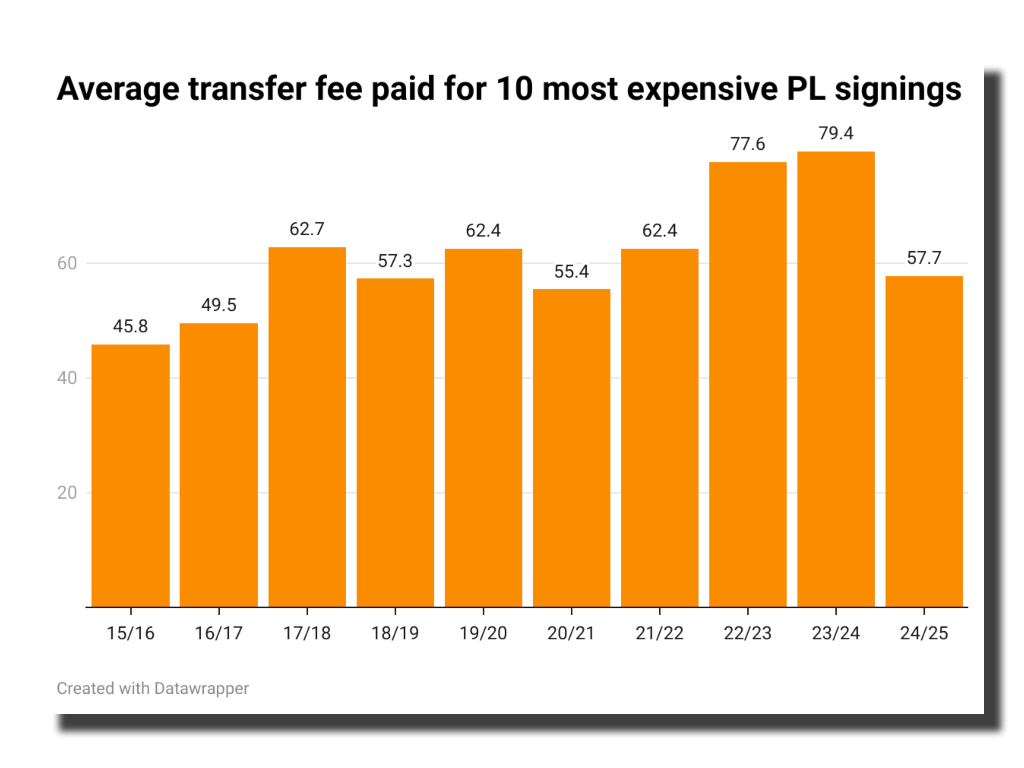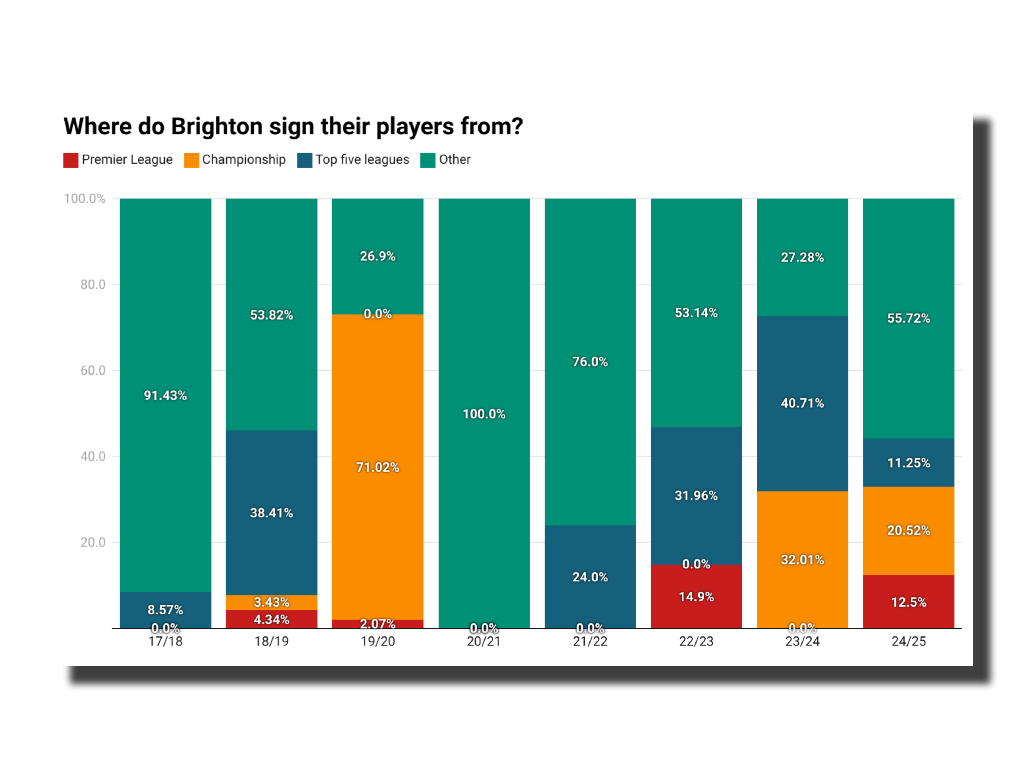Is there a limit to Brighton's transfer strategy?
The Seagulls seem to be stuck in mid-table and have begun moving away from the recruitment strategy that took them to the Premier League
Watching Brighton’s dramatic comeback against West Ham on Saturday - in which the Seagulls took the lead, then conceded two goals, only to then come back and win the game with a truly remarkable long-range shot from Carlos Baleba - I was struck by how far the club have come in the last seven or eight years.
Of course, beating this West Ham side isn’t a huge achievement, but it’s worth noting that Graham Potter’s faltering squad actually cost more money to put together (€433.9 million in transfer fees) than Fabian Hürzeler’s own squad (€385.4m). In fact, in a recent newsletter on where the Hammers have gone wrong in recent years, I drew a direct comparison between the two clubs and why the London club needed to take a page out of Brighton’s book when it came to scouting and recruitment. Few would doubt that Tony Bloom & co. have truly set the gold standard in that regard.
And yet, I wonder if there’s a limit to their success. Perhaps I’m just a cynical fool, but it’s worth noting that with four games of the season left (against tough opposition in Newcastle, Wolves, Liverpool and then Tottenham), Hürzeler’s team sit ninth on 51 points. That’s three positions lower and 11 points off what Roberto De Zerbi achieved two seasons ago. If you don’t look too hard, you would be forgiven for wondering whether Brighton have just plateaued in mid-table and are struggling to get back into contention for the European qualification spots.
That may sound like a lazy critique of Hürzeler’s first season at the club, but far from it. In fact, with an average of 1.5 points per game in the Premier League, the young Texas-born tactician is enjoying a better average than De Zerbi (1.39 points per game) and Potter (1.22). Instead, I’m drawn to the club’s transfer strategy in recent years and whether that could be coming under serious pressure due to Brighton’s elevated standing in the Premier League and the tougher challenges that come with that.
Admittedly, I’ve been pondering over this for much of the season, following a summer spending spree that felt distinctly un-Brighton in its make-up. While the club continued to pluck future stars from the relative backwaters of football (Stefanos Tzimas from Nuremberg, Ibrahim Osman from Nordsjaelland, etc.), they also spent huge sums of money on players from within English football. Yankuba Minteh joined the club from Newcastle and Georginio Rutter arrived from Leeds for a combined fee of just under €82m.
That was by no means the club’s entire budget - they’ve gone on to spend €280m on new players this season but it did make up around a third of the budget. Which is almost exactly how much of their budget Brighton spent last season on players from other English clubs (32 percent). But, as we can see in the table above, aside from the summer of 2019, when the club signed Adam Webster and Neal Maupay, this constitutes a pretty big rise in domestic signings for the Seagulls. And with more money spent on players comes a bigger risk to the club’s plans.
Of course, this is not a comment on the actual players signed from other clubs. Both Minteh and Rutter have been excellent this season and João Pedro’s forty goals and assists in 70 games since joining from Watford for €34m will likely see a number of clubs attempt to sign him in the coming summer transfer window. But the problem with each of these players is that the profit Brighton can expect from potential sales is so much lower than what they’ve typically been used to.
That, naturally, comes with more risks because while Brighton seem to be spending more money on these domestic signings, the going rate for them when the likes of Manchester United, Chelsea or Liverpool come calling hasn’t actually changed all that much. When we take the average transfer fee paid for the top 10 most expensive signings in the Premier League each season over the last 10 year, we get a graph like the one above, which showed a creeping climb from €45.8m to €62.4m between 2015 and 2022, before the fear of PSR rules forced English football to lose its collective mind and spend untold fortunes in the following two seasons. But, as we can see, that figure then dropped dramatically this season down to just €57.7m. And there’s little to suggest that it will leap upwards this summer.
Such a figure should be setting off alarm bells in Brighton’s recruitment and accountancy departments, because if the transfer fees paid for top-tier talents in English football doesn't steadily increase in line with the going rate for young talents such as Rutter or Minteh, it means clubs like Brighton get squeezed in the middle. This, naturally, swallows up their margins and makes the club’s job on and off the pitch much harder.
Of course, this isn’t just related to domestic signings. With Brighton’s growing reputation for developing young players and selling them for top prices, they’ve found themselves paying more money for players signed from other clubs in Europe’s top five leagues. Whether that be the €31.5m spent on Mainz winger Brajan Gruda or the €27m Lille demanded for Carlos Baleba in recent seasons, Brighton will also see their margins vanish with such signings if the aforementioned going rate for top-tier players doesn’t increase in the coming years.
So, with players signed in England or from France and Germany costing more and more each season, Brighton would be better going back to basics and scouting players from around the world that can still be signed for relatively cheap fees. And, to be fair to the club, they’ve done that this season, with the likes of Tzimas, Osman, Diego Gomez and Malick Yalcouyé joining the club for modest fees from relative obscurity. But there’s still a slight problem.
When we break all of Brighton’s signings down into four groups based on where they came from - Premier League, Championship, top five leagues in Europe and then everywhere else - we get a graph like the one above. And, as we can see, signings made from “other” in green used to dominate Brighton’s transfer budget between 2017 and 2022 to the tune of roughly 70% of the club’s total budget. But in the last three seasons that figure has shrunk rather dramatically down to just 45%.
That should perhaps be a worry for fans of the club. After all, no less than five of their top 10 sales of all time, like Moises Caicedo, Alexis Mac Allister and Deniz Undav came from this “other” category, while just three were signed from within English football or Europe’s top five leagues. In no uncertain terms, Brighton’s ability to identify such players from around the world is exactly what got them to where they are today. And a shift away from that recruitment strategy could have serious consequences for the club going forward.
And yet, that seems to be the cost of success. Perhaps Brighton would love to continue signing unknown stars from Belgium, Argentina or Scandinavia but the demands of being an ambitious mid-table club often means the need to buy ready-made stars to bolster your squad each and every season. Even if that comes at the cost of scouting and signing more long-term prospects that may need a few years to acclimate to Premier League football.
At the end of the day, the real world isn’t Football Manager and Brighton are just as susceptible to the changing winds of football as any other club in the Premier League. They’re just built on far stronger foundations and can weather the storm a little better than the likes of West Ham. But their recruitment strategy is changing ever so slightly from one season to the next and it will be interesting to see if that’s what’s needed to take them to the next level in the Premier League or whether a departure from their tried and tested methods may be a huge mistake.







Nice piece. Not sure Brighton would agree they've changed policy: they're still investing in young talent from around the globe. But as their talent evolves so the cost of replacing them almost inevitably increases, unless you are prepared to accept a big drop in quality. In short, it's easier (and cheaper) to replace a Bissouma than a Caicedo.
That said, Brighton are also good learners. I think last season taught them that De Zerbi was the wrong man and their poor league form in the second half (19th) indicated a deeper squad would be needed in order to play in Europe.
In context, West Ham were 18th in the PL over the second half of last season. Big investment there coupled with a new coach didn't deliver meaningful improvement. Brighton can be fairly content with finishing ~9th from a similar starting point.
My note of caution would be wage control. Wages have been 66% of turnover for the last two seasons, but if that ratio goes over 80% then the risk of unsustainability increases rapidly.
Do you reckon their change in transfer policy might have been the result of increased competition coming from other clubs copying their model? Seems even quite a few of the big teams have been scouting players directly from the South and Central American leagues over the last two seasons, maybe beating out Brighton on players they'd have like to sign themselves. Victim of their own success, perhaps?